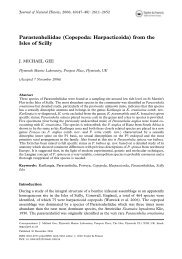An Updated Classification of the Recent Crustacea
An Updated Classification of the Recent Crustacea
An Updated Classification of the Recent Crustacea
You also want an ePaper? Increase the reach of your titles
YUMPU automatically turns print PDFs into web optimized ePapers that Google loves.
employed recently by Pérez Farfante and Kensley<br />
(1997).<br />
SUBORDER PLEOCYEMATA<br />
The Pleocyemata contains all nonpenaeoid decapods,<br />
whe<strong>the</strong>r swimming (natant) or crawling (reptant).<br />
The group appears to be monophyletic based<br />
on morphological data (e.g., Schram, 1984, 1986;<br />
Scholtz and Richter, 1995) and molecular data<br />
(e.g., Kim and Abele, 1990; Abele, 1991).<br />
INFRAORDER STENOPODIDEA<br />
For this section, we followed <strong>the</strong> classification provided<br />
by Holthuis (1993a), which does not appear<br />
to be very controversial. Authorship <strong>of</strong> <strong>the</strong> taxon<br />
Stenopodidea is changed from Bate (1888) to Claus<br />
(1872) at <strong>the</strong> recommendation <strong>of</strong> M. Tavares (pers.<br />
comm.). To our knowledge, <strong>the</strong>re has been only one<br />
new family-level taxon described since <strong>the</strong> Bowman<br />
and Abele (1982) work. Schram (1986) erected <strong>the</strong><br />
family Spongicolidae, so that <strong>the</strong>re are now two<br />
recognized families <strong>of</strong> extant stenopodideans (see<br />
also Holthuis, 1993a). Schram et al. (2000) recently<br />
described <strong>the</strong> first known fossil stenopodidean, also<br />
attributed to <strong>the</strong> Spongicolidae.<br />
INFRAORDER CARIDEA<br />
For <strong>the</strong> carideans, we followed, for <strong>the</strong> most part,<br />
<strong>the</strong> classification provided by Holthuis (1993a),<br />
which is very similar to that suggested by Chace<br />
(1992) (see also Vereshchaka, 1997b, for a key to<br />
caridean superfamilies modified slightly from Chace,<br />
1992). But in contrast with <strong>the</strong> relative lack <strong>of</strong> controversy<br />
over dendrobranchiate or stenopodidean<br />
classification, <strong>the</strong>re is apparently no consensus on<br />
<strong>the</strong> relationships or even <strong>the</strong> names <strong>of</strong> <strong>the</strong> incredibly<br />
diverse families <strong>of</strong> caridean shrimps. There have<br />
been several cladistic analyses conducted on groups<br />
<strong>of</strong> caridean families by M. Christ<strong>of</strong>fersen (see especially<br />
Christ<strong>of</strong>fersen, 1990). These studies would,<br />
if accepted, rearrange large numbers <strong>of</strong> caridean<br />
families. For example, in his 1986 paper, Christ<strong>of</strong>fersen<br />
placed seven families (oplophorids, atyids,<br />
pasiphaeids, alvinocarids, bresiliids, psalidopodids,<br />
and disciadids) in <strong>the</strong> superfamily Atyoidea, in contrast<br />
with Chace (1992) and Holthuis (1993a), who<br />
treated <strong>the</strong> Atyoidea as containing only <strong>the</strong> family<br />
Atyidae. Christ<strong>of</strong>fersen points out (pers. comm.)<br />
that, among <strong>the</strong> ‘‘glaringly non-monophyletic assemblages’’<br />
in our current classification, are <strong>the</strong> Alpheoidea,<br />
Hippolytidae, Pandaloidea, and Nematocarcinoidea.<br />
Adding to Christ<strong>of</strong>fersen’s frustration<br />
(pers. comm.) is that, whereas many authors<br />
comment on <strong>the</strong> unsatisfactory state <strong>of</strong> current classifications,<br />
especially as concerns such ‘‘wastebasket’’<br />
assemblages as <strong>the</strong> Hippolytidae and Pandaloidea,<br />
his own suggestions for novel arrangements<br />
have been slow to catch on. Chace (1997) recognizes<br />
<strong>the</strong> Hippolytidae Bate, and Holthuis (1993a)<br />
elected to synonymize a large number <strong>of</strong> Christ<strong>of</strong>fersen’s<br />
new taxa. Thus, we are left with <strong>the</strong> difficult<br />
task <strong>of</strong> following older yet clearly nonphylogenetic<br />
listings (e.g., Chace, 1992; Holthuis, 1993a)<br />
vs. cladistically generated phylogenetic arrangements<br />
(e.g., Christ<strong>of</strong>fersen, 1987, 1988a, b, 1989a,<br />
b, 1990) that seem to have little following in <strong>the</strong><br />
carcinological community and for which, in our estimation,<br />
some <strong>of</strong> <strong>the</strong> employed characters are<br />
questionable. We have followed Holthuis’s lead,<br />
more in deference to his vast knowledge <strong>of</strong> <strong>the</strong> carideans<br />
than for any o<strong>the</strong>r reason, while acknowledging<br />
that <strong>the</strong>re have been alternative phylogenetically<br />
based ideas presented in <strong>the</strong> literature. Only<br />
those superfamilies for which <strong>the</strong>re have been<br />
changes subsequent to Bowman and Abele (1982)<br />
are mentioned below.<br />
Superfamily Gala<strong>the</strong>acaridoidea<br />
The family Gala<strong>the</strong>acarididae and its superfamily<br />
Gala<strong>the</strong>acaridoidea were both described by Vereshchaka<br />
(1997b) for <strong>the</strong> species Gala<strong>the</strong>acaris abyssalis<br />
based on a single specimen. Additional specimens<br />
have since been found in <strong>the</strong> stomachs <strong>of</strong><br />
deep-sea lancetfish (Chow et al., 2000).<br />
Superfamily Bresilioidea<br />
This assemblage has long been recognized as being<br />
an artificial group in dire need <strong>of</strong> revision (e.g., see<br />
Forest, 1977). Holthuis (1993a) elected to treat <strong>the</strong><br />
Bresiliidae as a family and placed in synonymy<br />
some <strong>of</strong> <strong>the</strong> recently proposed families (Agostocaridae,<br />
Alvinocarididae). We have treated <strong>the</strong> group<br />
as an (admittedly) artificial superfamily containing<br />
five caridean families that may or may not be related.<br />
Three <strong>of</strong> <strong>the</strong>se families are new (i.e., <strong>the</strong>y<br />
were not included in <strong>the</strong> Bowman and Abele (1992)<br />
classification): <strong>the</strong> family Agostocarididae was<br />
erected by Hart and Manning (1986), <strong>the</strong> Alvinocarididae<br />
was proposed by Christ<strong>of</strong>fersen (1986),<br />
and <strong>the</strong> Mirocarididae was described by Vereshchaka<br />
(1997a).<br />
Christ<strong>of</strong>fersen’s (1986) family Alvinocarididae is<br />
recognized to accommodate <strong>the</strong> majority <strong>of</strong> <strong>the</strong><br />
morphologically similar ‘‘bresilioid’’ shrimp from<br />
hydro<strong>the</strong>rmal vents. The family was more thoroughly<br />
(although still somewhat incompletely) diagnosed<br />
by Segonzac et al. (1993) in a footnote and<br />
also by Vereshchaka (1996, 1997a) (see also Shank<br />
et al., 1999). Vereshchaka (1997a) created a new<br />
genus (Mirocaris) and family, <strong>the</strong> Mirocarididae,<br />
for <strong>the</strong> hydro<strong>the</strong>rmal vent shrimp described originally<br />
as Chorocaris fortunata by Martin and Christiansen<br />
(1995b).<br />
Superfamily Campylonotoidea<br />
The family Bathypalaemonellidae was established<br />
(although without a description or diagnosis and<br />
without mention <strong>of</strong> <strong>the</strong> genus Bathypalaemonella;<br />
see Holthuis, 1993a:87) by Saint Laurent (1985).<br />
The family is placed in <strong>the</strong> superfamily Campylon-<br />
Contributions in Science, Number 39 Rationale 45











